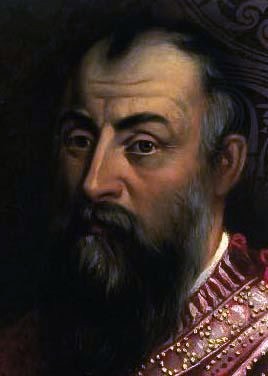Sir William Warren (died 1602) facts for kids
Sir William Warren lived a long time ago, from about 1558 to 1602. He was an important person in Ireland: a landowner, a politician, and a soldier in the late 1500s. People mostly remember him for helping with a famous marriage. He helped Hugh O'Neill, Earl of Tyrone marry his third wife, Mabel Bagenal, at Warren's home, Drumcondra Castle, in 1591.
Contents
Sir William Warren's Family Life
William Warren was the son of Captain Humphrey Warren and Elizabeth Clifford. His father, Humphrey, was an English soldier who came to Ireland around 1550. He worked for the English Queen and was trusted by three different rulers. Humphrey was also a close friend of Thomas Radclyffe, 3rd Earl of Sussex, who was in charge of Ireland for a while. Humphrey was a Member of Parliament for Carrickfergus in 1559.
William's mother, Elizabeth Clifford, came from an important family in England. She had been married twice before. Her first husband was Sir William Brabazon, a high-ranking official in Ireland. Her second husband was Christopher Blount. After Humphrey Warren died, Elizabeth married a fourth time to Sir Edward Moore. This meant William Warren grew up connected to many powerful families in Ireland. He was the half-brother of Edward Brabazon, 1st Baron Ardee, and Garret Moore, 1st Viscount Moore.
William and his brother Henry also married into important families. Henry married Alice Loftus, whose father, Adam Loftus, was the Archbishop of Dublin. William married Jenet Finglas sometime after 1586. Jenet was the daughter of Patrick Finglas and the widow of John Bathe, who was a financial officer for the government. Through this marriage, William gained control of a lot of land in County Dublin and also Drumcondra Castle.
Jenet, William's wife, was a Roman Catholic. This caused some problems for William. At that time, people who held important jobs in Ireland had to promise to accept the Queen as the head of the Church of Ireland. William was suspected of secretly sharing his wife's Catholic beliefs. Jenet was known to welcome Catholic priests at Drumcondra Castle. The government watched her activities even after William died.
William Warren and Hugh O'Neill
William Warren was a military leader. In 1586, the Lord Deputy of Ireland, Sir John Perrot, asked him to talk with Sorley Boy MacDonnell. Sorley Boy was a powerful Scottish leader who had taken control of land in County Antrim. William's father had been friends with Sorley Boy, and William successfully convinced him to make peace with Elizabeth I. William wanted to be in charge of Carrickfergus, but he never got the job. Like his half-brother Garrett, William became a close friend of Hugh O'Neill, Earl of Tyrone.
Hugh O'Neill's Marriage to Mabel Bagenal
Hugh O'Neill's third marriage in August 1591 was to Mabel Bagenal. Mabel was the daughter of Sir Nicholas Bagenal, a high-ranking military officer in Ireland. This marriage is a famous story in Irish history. Some people think it was a true love story, while others believe O'Neill married Mabel to gain power through her family. What is clear is that William Warren and his wife played a big part in the wedding.
Mabel was staying with her sister Mary and Mary's husband, Patrick Barnewall, at Turvey House. She then went to Drumcondra Castle, about six miles away, where O'Neill soon joined her.
One story says that Warren visited Mabel at Turvey House and pretended to "kidnap" her, but she was actually in on the plan. They then rode to Drumcondra, where O'Neill met them. Mabel wanted a Protestant wedding ceremony. So, Thomas Jones, the Bishop of Meath, married them at Drumcondra Castle. The Bishop later said he only did the ceremony to protect Mabel's reputation. After the wedding, there were five days of celebrations. Then, the newlyweds went to O'Neill's home in Dungannon. People said Warren visited O'Neill often and even went to Catholic Mass with him. These stories made the Queen's government suspect Warren's loyalty.
Challenges During the Nine Years' War
The Nine Years' War was a major rebellion against English rule in Ireland. Hugh O'Neill was the main leader of the Irish side. This war put William Warren in a very difficult spot. Even though his parents were English and he had powerful family connections, his close friendship with O'Neill, who was seen as a rebel, and the suspicion that he was secretly Catholic, made people question his loyalty. Warren insisted he was ready to fight O'Neill and even try to make him surrender.
By 1596, the government doubted Warren so much that he was called to a hearing. Even though he was very sick, he had to appear before the Irish Privy Council. He was scolded and threatened with prison, but he was not actually jailed.
Later Years and Legacy
William Warren's situation improved when Robert Devereux, 2nd Earl of Essex became the Lord Deputy of Ireland. Warren was well-liked by Essex and even hosted him at Drumcondra Castle. After Essex lost power, Warren quickly became friends with Robert Cecil, 1st Earl of Salisbury, a new powerful figure in the English court. Thanks to Cecil, Warren finally got the job he wanted: Governor of Carrickfergus. However, he died soon after.
William and Jenet had several daughters, but no sons. One of their daughters married William's stepson, James Bathe. When William died, his lands went back to the Bathe family. His widow, Jenet, later married Terence O'Dempsey, 1st Viscount Clanmalier. She died in 1627.
Related Information
- Hugh O'Neill, Earl of Tyrone
- Making History


